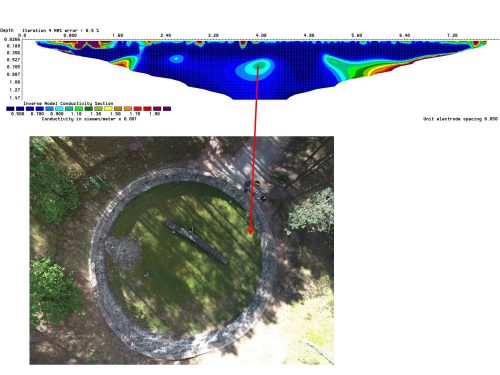Historical discovery in Lithuania: for the first time since World War II, the famous tunnel dug by prisoners from the Stutthof concentration camp, in an attempt to escape from the Nazis, has been located using ground-penetrating photography technology *
The tunnel was revealed in a joint work of the Antiquities Authority, the University of Hartford in the USA, the Jewish National Museum named after the Genius of Vilna, the Advision company and the PBS popular science series NOVA

An exciting discovery in the Ponar forest near Vilnius: a test using ground-penetrating photographic technology discovered - for the first time since World War II - an escape tunnel dug by prisoners of a concentration camp, with the aim of escaping the clutches of the Nazis.
100,000 people, of which 70,000 were Jewish residents of Vilnius and its surroundings, were executed and thrown into pits in the Ponar forest near Vilnius, in Lithuania, during World War II. During the withdrawal of the German forces from the Eastern Front, a special unit was established in 1943 whose task was to obscure the traces of the mass extermination. In Ponar, the task was assigned to work groups of 80 prisoners from the Stutthof concentration camp.
During the night the prisoners were kept in a deep pit, and during the day they worked opening the graves of the brothers, removing the bodies, arranging them in piles and burning them, and this - with their feet chained.
The workers, who knew very well that when their work was finished they would also be executed, dug a tunnel about 35 meters long, which led from the pit where they stayed at night, to beyond the fences.
At the end of 3 months of hard work, on the night of April 15, 1944, the escape took place. The prisoners sawed the cables on their feet with a nail, and 40 of them went out through the tunnel.
However, they were soon discovered by the guards. 15 of them managed to escape, and 11 of them joined the partisans and survived the war. The rest of the escapees were captured or shot to death.
Among other things, Ponar was burned into the Israeli collective memory, through the well-known song of the late partisan from the Kacharginsky background, sung by Chava Elberstein. Since World War II, the location of the escape tunnel has not been known, despite several attempts to discover it.
Now, in the joint work of Dr. Yohanan (John) Seligman on behalf of the Antiquities Authority, Prof. Richard Freund from the University of Hartford in the USA, the Jewish National Museum for the Genius in Vilna, the Advision company and the PBS popular science series NOVA , the escape tunnel was rediscovered. With the method of underground imaging (Electrical Resistivity Tomography), near the pit where the prisoners were kept, the location of the tunnel is clearly visible.

According to Dr. John Seligman from the Antiquities Authority, "As an Israeli whose ancestors came from Lithuania, I was moved to tears at the moment of the discovery of the tunnel. This is a touching testimony to the victory of hope over despair. The digging and uncovering of the tunnel will allow us to present not only the horror of the Holocaust, but also the hope for life."
According to the Minister of Culture and Sports, MK Miri Regev, "I congratulate the Antiquities Authority for an extraordinary international cooperation, which will allow us to turn a story into reality. The exciting and important discovery of the prisoners' tunnel is yet another convincing proof against Holocaust deniers. The technological developments, which allow the Jewish people to reveal more and more stories of heroism that the Nazis tried to cover up, are a gain and an achievement for all of humanity."
The partners intend to return to the site in the near future to uncover the tunnel, so that it can be presented to the public as part of the memorial site for the Jews of Vilnius and the surrounding area.
To the testimony of Mordechai Seidel, a partisan who survived the escape tunnel operation and was rescued Yad Vashem website

2 תגובות
Voila, you managed to locate tunnels with the help of technology, perhaps from the University of Hartford.
You might also discover tunnels that go out of Gaza. Judge since we heard there was tunneling technology and discovery from months ago. And we have to prepare for the discoveries of tunnels from Gaza, we haven't heard anything. What I did hear is that the Solel Bona company wants to dig a wall deep into the ground at the border of Gaza Israel so that it will prevent the digging of tunnels. So apparently the technology for discovering tunnels announced by the Israel Defense Forces and various scientists does not completely live up to expectations... too bad...
I wonder if it is relevant to the discovery of tunnels from Gaza